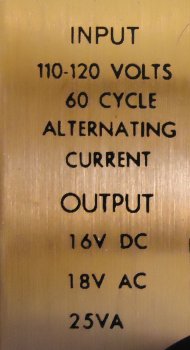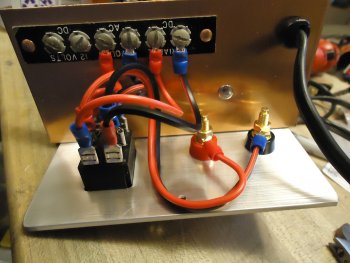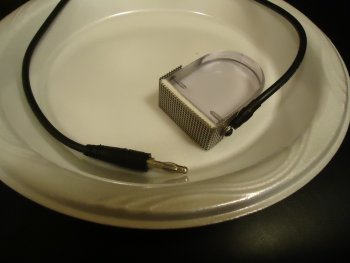You are using an out of date browser. It may not display this or other websites correctly.
You should upgrade or use an alternative browser.
You should upgrade or use an alternative browser.
New etcher build
- Thread starter Gliden07
- Start date
Ted, best I can tell from the drawing you've got it wired correct. The banana jacks both go to the center terminals of the switch just as you have them drawn in. Both of the DC (+ and -) both will go to the top two terminals, just as you've drawn them. Both of the AC wires will go to the bottom two terminals.
You've also got the red wiring going to the positive (+) terminal? I don't see which of them is marked + and which is negative - perhaps they're not marked because it depends on position of a switch on front panel? Doesn't matter, I'd keep the red wires to positive side (just because red is normally positive in the DC world). Also, be sure the positive (red) wire is going to the blade, with the negative (black) going to the marking tool.
Yes, you'll find the max voltage will work best. Once you're working with stencils you might like to cut back to 5 to 10 second or so marks, but use several of them. This prevents the stencil from heating up too much (excessive heat will shorten a stencils life), and lifting marking tool releases any gas that's built up between blade and tool. You'll get a faster, cleaner mark with several shorter marks, than with just a couple long marks.
As ya'll have seen, there's nothing to building a electro-etch power supply. Simple, easy, and cheap. Those train transformers are the way to go for sure. I hadn't thought of them before. I usually have an old low voltage transformer laying around in junk box, and rest of parts are in parts bin for sure.
Ken H>
You've also got the red wiring going to the positive (+) terminal? I don't see which of them is marked + and which is negative - perhaps they're not marked because it depends on position of a switch on front panel? Doesn't matter, I'd keep the red wires to positive side (just because red is normally positive in the DC world). Also, be sure the positive (red) wire is going to the blade, with the negative (black) going to the marking tool.
Yes, you'll find the max voltage will work best. Once you're working with stencils you might like to cut back to 5 to 10 second or so marks, but use several of them. This prevents the stencil from heating up too much (excessive heat will shorten a stencils life), and lifting marking tool releases any gas that's built up between blade and tool. You'll get a faster, cleaner mark with several shorter marks, than with just a couple long marks.
As ya'll have seen, there's nothing to building a electro-etch power supply. Simple, easy, and cheap. Those train transformers are the way to go for sure. I hadn't thought of them before. I usually have an old low voltage transformer laying around in junk box, and rest of parts are in parts bin for sure.
Ken H>
Gliden07
Well-Known Member
Ted I just saw this hope it works for you. Mine worked AWESOME!! Waiting for my stencils now. I ordered them from Ernie. I'm actually holding off on finishing a knife so I can mark my first blade. I did run mine at full power that seemed to work best in the etch. The AC for the mark worked perfect. The test etch I had pics on was nice and even so even though the etch part of this is a tad underpowred it may be a good thing as you have more control over it. I will do more testing when I get the real stencils for time. Goodluck keep posting.
Last edited:
Smallshop
KNIFE MAKER
speak english.....lolTed what does that 12VDC output put out for current?? Is it run in parallel or series with the other variable output?
Last edited:
Gliden07
Well-Known Member
speak english.....lol
If that output is in parallel with the max dc output on the variable connection. You could hook that up and get the max output on the DC without the variable knob. Basically it would render the knob useless if you used that output. But you wouldn't know that unless you had a meter for sure. If it's in series or is totally seperate from the variable DC output you may be able to boost the output of the DC side? I doubt it is set up like that though. Now that I've totally confused you!! LOL!!
Gliden07
Well-Known Member
Looks like your ready to go!! Where did you get that switch. I looked around a little bit and never found one. Is it lit??
Last edited:
Smallshop
KNIFE MAKER
Ted, if you could get a good shot of the nameplate on your train xformer might give some idea of current carrying ability of your setup. Seems like we checked that before you purchased it, but don't remember details.

Ken...the non adjustable terminal (dc) shows 12v (see the wiring photo)...so I don't know if they made changes?
Last edited:
Smallshop
KNIFE MAKER
Smallshop
KNIFE MAKER
Looks like your ready to go!! Where did you get that switch. I looked around a little bit and never found one. Is it lit??
https://www.amazon.com/gp/product/B0094GCA8G/ref=oh_aui_detailpage_o08_s00?ie=UTF8&psc=1
Supposed to light...doesn't....maybe due to the low voltage?
OK, your 25VA is going to be around 1.3 amps max at 18 volts, and 1.5 amps max at 16 volts. Since you're using only one voltage at a time you'll have full access to full 25VA. To calculate amps for a VA rating, just divide the VA/Volts used.... i.e. 25VA/16vdc=1.56 amps.
The current (amps) used will depend on size of stencil, how much "open" space there is, type of electrolyte, and voltage applied. I think I mentioned somewhere before for a small stencil like I use, the current draw is usually an amp or less (and that's max), but is usually a bit less than 1/2 amp. If there is less current available, it'll just etch a bit slower. Keep a check on the heat of stencil and you'll be fine. Be sure not to hold marking tool solid on stencil too long at a time, checking amount heat building. "IF" you ever see smoke..... you've held it too long {g}
Ken H>
The current (amps) used will depend on size of stencil, how much "open" space there is, type of electrolyte, and voltage applied. I think I mentioned somewhere before for a small stencil like I use, the current draw is usually an amp or less (and that's max), but is usually a bit less than 1/2 amp. If there is less current available, it'll just etch a bit slower. Keep a check on the heat of stencil and you'll be fine. Be sure not to hold marking tool solid on stencil too long at a time, checking amount heat building. "IF" you ever see smoke..... you've held it too long {g}
Ken H>
Gliden07
Well-Known Member
https://www.amazon.com/gp/product/B0094GCA8G/ref=oh_aui_detailpage_o08_s00?ie=UTF8&psc=1
Supposed to light...doesn't....maybe due to the low voltage?
Yup its 125-250VAC
Smallshop
KNIFE MAKER
Guys...after all the work I was etching the first blade with the low rez stencil...and I'm thinking to myself that there is a lot going on there...a lot that would require me to sit working on these for a long time...I thought through my "failure" on the CNC attempts...there were many...and came up with something that works pretty well....
https://knifedogs.com/threads/makers-mark-on-steel.47172/
https://knifedogs.com/threads/makers-mark-on-steel.47172/



